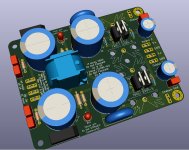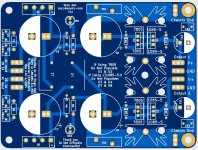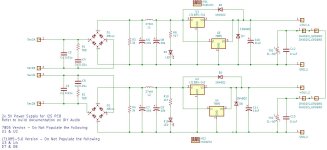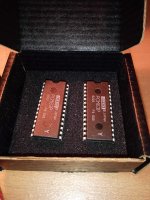TH with cap would be my preference for this type of psu. Your right about the size of the CL60, but probably the most common type in yours, mine and many other DIY'ers stash. Plus its still smaller the the BR option.
Since my knowledge in EE is limited, I cannot offer an opinion on which to use. I can ask if one way is better, more reliable, more safe, less costly, easier to assemble, less hassle,....than the other.
I have both Miro's AD1862 and AD1860 DAC boards and I realize this is a silly idea to most people but I am thinking that I would like to have them in the same chassis, with one Miro PSU and one Bluetooth source module and use a switch plus non latching relays to alternate between the two DACs.
I happen to have an on-on 6PDT switch that would toggle the power from the PSU between the DACs but I would use non latching relays (probably two 4formCs) to switch the inputs and outputs. Will it be ok to power those relays from the Miro PSU that powers the DACs? And is there any other reason why this is a problematic idea? I know its a, "Why bother?" to pretty much everyone, however unless there is something I am overlooking which constitutes a problem for stability, sound quality etc., I plan to give it a go.
I happen to have an on-on 6PDT switch that would toggle the power from the PSU between the DACs but I would use non latching relays (probably two 4formCs) to switch the inputs and outputs. Will it be ok to power those relays from the Miro PSU that powers the DACs? And is there any other reason why this is a problematic idea? I know its a, "Why bother?" to pretty much everyone, however unless there is something I am overlooking which constitutes a problem for stability, sound quality etc., I plan to give it a go.
Spice files for post #8020 ?
No problem.
You can see that when operating at 12V rails, and 2Vrms output, THD is about -90dB.
H2 is 0.0022%, H3 is 0.0015%.
THD goes up by 2x at 10kHz.
The diamond buffer contributes some 40% to the THD, even when not loaded.
Patrick
.
No problem.
You can see that when operating at 12V rails, and 2Vrms output, THD is about -90dB.
H2 is 0.0022%, H3 is 0.0015%.
THD goes up by 2x at 10kHz.
The diamond buffer contributes some 40% to the THD, even when not loaded.
Patrick
.
Attachments
Last edited:
Relay draws small current, about 20mA, so you can use it 😊I have both Miro's AD1862 and AD1860 DAC boards and I realize this is a silly idea to most people but I am thinking that I would like to have them in the same chassis, with one Miro PSU and one Bluetooth source module and use a switch plus non latching relays to alternate between the two DACs.
I happen to have an on-on 6PDT switch that would toggle the power from the PSU between the DACs but I would use non latching relays (probably two 4formCs) to switch the inputs and outputs. Will it be ok to power those relays from the Miro PSU that powers the DACs? And is there any other reason why this is a problematic idea? I know its a, "Why bother?" to pretty much everyone, however unless there is something I am overlooking which constitutes a problem for stability, sound quality etc., I plan to give it a go.
You don't have to worry about any signal problems, it will work.
Followup to post 8030.
Attached are Gerbers & a build guide doc including BOM for a power supply PCB for your I2S/USB boards (5V@400mA + 5V@100mA)
This has 2 independent regulated 5V rails with CLC pre-filtering, snubbers, and TH || cap ground breakers. Feed it from 2 pairs of transformer secondaries.
Get some made at your favorite board fab (JLCPCB or similar) and share the extras with your fellow builders.
Thanks to Miro1360 for the fine DAC work, and to Kokanee and Vunce for the inspiration and input on this board.
Attached are Gerbers & a build guide doc including BOM for a power supply PCB for your I2S/USB boards (5V@400mA + 5V@100mA)
This has 2 independent regulated 5V rails with CLC pre-filtering, snubbers, and TH || cap ground breakers. Feed it from 2 pairs of transformer secondaries.
Get some made at your favorite board fab (JLCPCB or similar) and share the extras with your fellow builders.
Thanks to Miro1360 for the fine DAC work, and to Kokanee and Vunce for the inspiration and input on this board.
Attachments
This is great, I just sent the PSU 1 ECO to jlcpcb planning to use it as my 5v supply board from dual 9v secondaries. This will work even better. On that note Newark has this transformer on sale if anyone is interested. Cant go wrong for 7.88 Usd.
https://canada.newark.com/multicomp/vtx-146-030-109/toroidal-transformer-30-va-2-x/dp/33P8744
https://canada.newark.com/multicomp/vtx-146-030-109/toroidal-transformer-30-va-2-x/dp/33P8744
Last edited:
Hi all! Please help me how to check AD1862N for serviceability. On AA DDE 3.0 DAC suddenly lost sound. With power off DAC and USB-transport board, I2S cable was bitten off with the help of cutters, then a jumper from pin 22 to pin 19 was thrown to the HDCD filter PMD-100 (to disable an attenuator). Then the DAC was turned on and found out that there is no sound in both channels on Coax, Toslink and I2S (all of inputs). All voltages on the board are normal, the Lock indicator lights up, and when turning on a stream with HDCD signature the indicator also lights up on the input that is connected to the specific source. I found information on how to check DAC chips for serviceability by measuring resistances between certain pins. I measured resistances on the extracted chips - everything turned out to be normal. But when the DAC for some reason there is no signal on the (analog) oscilloscope on pin11 (lout). On pin 7 (from the digital filter) the signal comes (even pulses are visible). Help me, please!
Last edited:
You can go wrong with a 230v primary... for most of us in North America, anyway...This is great, I just sent the PSU 1 ECO to jlcpcb planning to use it as my 5v supply board from dual 9v secondaries. This will work even better. On that note Newark has this transformer on sale if anyone is interested. Cant go wrong for 7.88 Usd.
https://canada.newark.com/multicomp/vtx-146-030-109/toroidal-transformer-30-va-2-x/dp/33P8744
The 5V psu and Gerber files was an unexpected surprise, even includes a mini build guide!Followup to post 8030.
Attached are Gerbers & a build guide doc including BOM for a power supply PCB for your I2S/USB boards (5V@400mA + 5V@100mA)......
Thank You Randy.

Anyone tried to connect DDC (like singxer) as source to any Miro dac? DDC usually use I2S output.
I ran I2S over HDMI to an Ian Canada HDMI receiver, and from there to the shift registers on the 1865 board. It was nowhere close to I2Sover USB bypassing the shift registers. I imagine the lack of reclocking by the HDMI receiver was the bottle neck, which could be overcome with more of Ian's gear. I do use the external oscillator board with the I2SoverUSB, and still this is more cost effective than Ian's FIFO reclocking options. The streamer was a Magna Mano Ultra-III which bested the Denefrips Hermes DDC in my system, with another brand name DAC. I am a complete USB convert.
Everything has its price. 🤣They are burning intensely right now. 🤣
What is your impression? PCM63P-K vs PCM63P-Y vs AD1862 ?? 😉
Last edited:
It's all very similar. The PCM63P-Y gives the brightest sound so you need to choose your I/V opamp carefully. We will see the result with some tubes, it will be something completely different.
I do not know. Very strange chip. When I listen to it, I have the impression that all the tracks play faster than on others. It does NOT forgive if the recording is bad or if the sound designer and production is not top-notch. The brain struggles to process the amount of information coming out of it. It is not for everyone's ears. Especially for the 'basshead' listener/preference in music. Or who likes soft and warm reproduction. Maybe it can be compensated with a dedicated opamp, but then the sound of the opamp becomes dominant.It's all very similar. The PCM63P-Y gives the brightest sound so you need to choose your I/V opamp carefully. We will see the result with some tubes, it will be something completely different.
- Home
- Source & Line
- Digital Line Level
- DAC AD1862: Almost THT, I2S input, NOS, R-2R




